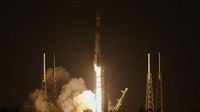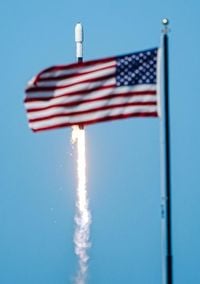In the quiet hours of Tuesday morning, July 8, 2025, SpaceX once again demonstrated its relentless pace of innovation and deployment, launching the Starlink 10-28 mission from Cape Canaveral Space Force Station. The Falcon 9 rocket lifted off precisely at 4:21 a.m. EDT, carrying 28 broadband internet satellites destined for low-Earth orbit. This mission marked yet another milestone in SpaceX's ambitious quest to blanket the globe with high-speed internet access.
The launch took place from Space Launch Complex 40, despite an earlier Federal Aviation Administration advisory that had listed NASA's Kennedy Space Center pad 39A as the launch site. Such last-minute changes have become somewhat routine, reflecting the dynamic nature of modern space operations.
What made this launch particularly notable was the Falcon 9 first stage booster used—designated B1077—taking to the skies for the 22nd time. This booster has a storied history, having previously supported NASA's Crew-5 mission, the GPS III Space Vehicle 06, and 17 earlier Starlink satellite deployments. Its durability and reusability underscore SpaceX's pioneering approach to reducing costs and increasing launch cadence.
After stage separation, B1077 completed its return journey by landing on the droneship A Shortfall of Gravitas stationed in the Atlantic Ocean. The touchdown occurred approximately eight minutes and 14 seconds after liftoff, marking the 117th successful landing for this particular droneship and the 473rd booster landing overall for SpaceX. These numbers highlight the company's remarkable track record in booster recovery, a key factor in their operational efficiency.
The Starlink 10-28 mission added to an already impressive launch tempo from Florida's Space Coast. By July 8, 2025, the region had witnessed 59 orbital rocket launches so far this year from both Cape Canaveral Space Force Station and Kennedy Space Center. This pace is unprecedented, with 56 orbital rockets having taken flight during the first half of the year alone. If this momentum continues, it will surpass 2024's record of 93 launches, setting a new benchmark for space activity in the region.
Just a week prior, SpaceX had kicked off July with a doubleheader launch day. On July 1, the company successfully launched the MTG-S1 mission, deploying the European Space Agency's Meteosat Third Generation Sounder satellite from Kennedy Space Center's Pad 39A at 5:04 p.m. The following night, the Starlink 10-25 mission lifted off at 2:28 a.m. from Launch Complex 40, deploying another batch of Starlink satellites. These back-to-back launches exemplify SpaceX's ability to maintain a rapid launch cadence, a feat that few other organizations can match.
Weather conditions for the Starlink 10-28 launch were favorable, with the National Weather Service forecasting a 30% chance of showers and thunderstorms primarily before 2 a.m., followed by mostly cloudy skies and mild winds. Such conditions are typical for Florida's Space Coast, yet SpaceX and its partners have become adept at navigating these challenges to keep their launch schedule on track.
Looking ahead, Space Force officials have announced an $81.6 million contract awarded to SpaceX for the USSF-178 mission, slated for the first half of the 2027 fiscal year. This mission will carry the Weather System Follow-on-Microwave Space Vehicle 2 (WSF-M2), designed to enhance global weather sensing capabilities, as well as BLAZE-2, a collection of Department of Defense small satellites dedicated to operational, research, development, and prototype purposes. This contract reflects growing confidence in SpaceX's reliability and the increasing integration of commercial launch providers into national security and scientific endeavors.
SpaceX's Starlink constellation continues to grow steadily, aiming to provide high-speed internet access to underserved regions worldwide. Each launch adds dozens of satellites, expanding coverage and capacity. The 28 satellites aboard the Starlink 10-28 mission will join thousands already in orbit, forming a vast network that is transforming how people connect to the internet.
The Falcon 9 booster B1077's 22nd flight is a testament to the strides made in rocket reusability. Previously, this booster supported critical missions like NASA's Crew-5, which ferried astronauts to the International Space Station, and GPS III Space Vehicle 06, enhancing global navigation systems. Its repeated use reduces costs and turnaround times, enabling SpaceX to sustain a high launch frequency without the prohibitive expense of building new boosters for every mission.
Landing on the droneship A Shortfall of Gravitas is a well-choreographed ballet of precision and timing. The droneship itself has become an iconic element of SpaceX's operations, having hosted 117 booster touchdowns. These landings not only recover expensive hardware but also symbolize the company's commitment to sustainable spaceflight practices.
SpaceX's rapid launch cadence from Florida is reshaping the aerospace landscape. The region, long a hub for space exploration, is now witnessing an unprecedented surge in activity. This surge is driven not only by commercial ventures like Starlink but also by government contracts and international collaborations, such as the MTG-S1 weather satellite for the European Space Agency.
Rick Neale, Space Reporter at Florida Today, notes that this pace of launches is setting new records and pushing the boundaries of what is possible in spaceflight. His coverage highlights the intricate coordination and technological prowess behind each mission, offering readers a front-row seat to the unfolding space revolution.
SpaceX's success also raises questions about the future of space traffic management and orbital debris mitigation. As the Starlink constellation grows, so does the need for responsible stewardship of Earth's orbital environment to ensure long-term sustainability.
Yet, for now, the focus remains on the remarkable achievement of sending 28 satellites skyward in the early morning hours, expanding internet access and pushing humanity further into the space age. The Starlink 10-28 mission exemplifies the blend of innovation, determination, and precision that defines modern spaceflight.
With the Falcon 9 booster B1077 safely back on its droneship and the new satellites successfully deployed, SpaceX continues to turn ambitious plans into reality. As the company looks to future missions and contracts, including those supporting national security and scientific research, the Space Coast stands as a beacon of human ingenuity and exploration.





